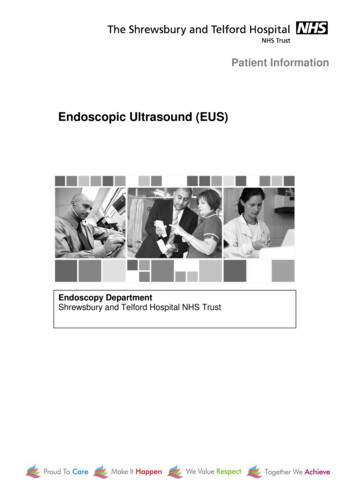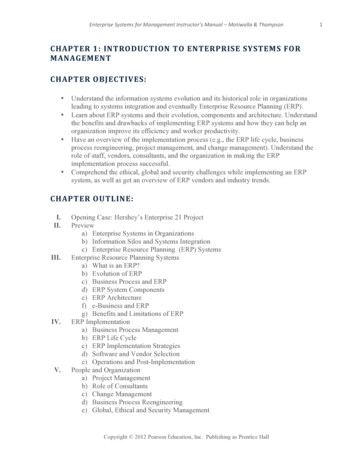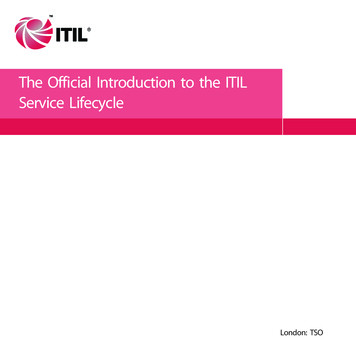
Transcription
0. INTRODUCTION.1. ABOUT THIS GRAMMAR-The professional of language-The informed reader-About glosses-Naming morphemes-About grammars-Apologies2. LOCATION3. A LITTLE ABOUT EUSKARA'S HISTORYCHAPTER 1: THE SENTENCE0. BASIC ELEMENTS IN THE SENTENCE: A FEW EXAMPLES1. ORDER OF PHRASES IN THE SENTENCE.1.0. Neutral word order.1.1. Free word order.1.2.Galdegaia: the informationally relevant phrase.2. ABSENT PHRASES.2.1. In infinitival sentences.2.2. Absent phrases and galdegaia.2.3. Absent pronouns.3. TYPES OF SENTENCES.3.1. Declarative sentences.3.2. Negative sentences.3.2.1. Negation and word order.3.2.2. Negation and galdegaia.3.3. Interrogative sentences.3.3.1. Yes/no questions.3.3.2. Partial questions.3.4. Causative sentences.3.5. Impersonal sentences.CHAPTER 2: THE NOUN PHRASE1. NOUN PHRASES: THE BASICS.2. NOUNS.2.1. Noun phrases headed by common Nouns.2.2. Noun Phrases headed by proper Nouns2.3. Gender3. ADJECTIVES: WORD ORDER.3.1. Adjectives and their complements.3.1.1. Participials.4. COMPLEMENTS AND MODIFIERS OF THE NOUN.4.1. ko and ren phrases.4.2. beste 'other'.
5. QUANTIFIERS.5.1. Numerals5.1.1. Ordinals5.1.2. Distributives5.1.3. A partial list of numerals5.2. Quantifiers that require a determiner.5.3. Determinerless quantifiers.6. DETERMINERS.6.1. The determiner 'a'.6.1.1. Definite Noun Phrases.6.1.2. Indefinite environments.6.1.2.1. Atributes.6.1.2.2. Generic sentences.6.1.2.3. Indefinite objects and subjects.6.1.2.4. Existential or presentational sentences.6.2. Demonstratives.6.2.1. Emphatic demonstratives.6.2.2. Demonstratives used as pronouns.7. NUMBER.7.1. Number and Determiners.7.2. Proximity plural determiner ok.8. PRONOUNS.8.1. Person pronouns8.1.1. Emphatic person pronouns.8.2. Interrogative pronouns.8.3. Indefinite pronouns derived from interrogatives.8.3.1. Existential indefinites.8.3.2. Universal, free-choice indefinites.8.3.3. Negative Polarity Items.8.3.4. Plural interrogatives.8.4. Anaphors and reciprocals.CHAPTER 3: CASES AND POSTPOSITIONS1. GRAMMATICAL CASES: THE BASICS.1.1. Absolutive case.1.2. Ergative case.1.3. Dative case.2. PARTITIVE.2.1. Partitive as a polar determiner.2.2. Partitive and absolutive.3. POSTPOSITIONS.3.1. Declension versus agglutination.3.2. Changes induced by morpheme merger.3.3. Locational postpositions.3.3.1. Animacy: the morpheme ga.3.3.2. Singular determiners versus others: the morpheme ta.3.4. Other postpositions.
CHAPTER 4: THE VERB AND ITS MORPHOLOGY1. THE VERB AND ITS MORPHOLOGY: A QUICK OVERVIEW.2. THE VERB.2.1. Transitives and intransitives.2.1.1. Weather predicates.2.1.2. Borderline transitive verbs: Unergatives and others.2.1.3. Intransitives: Unaccusatives and others.2.1.4. Inchoatives.2.1.5. Causatives.2.2. Synthetic and periphrastic.3. ASPECT.3.1. The perfective.3.2. The imperfective.3.2.1. The progressive ari construction.3.3. The unrealized.CHAPTER 5: VERBAL INFLECTION1. AUXILIARY SELECTION.2. AGREEMENT.2.1. How agreement works: the basics.2.2. The paradigms of agreement morphology.2.2.1. The persons.2.2.2. Phonological changes.2.2.3. The third person.2.2.4. A few full paradigms and how to use them.3. TENSE: PAST TENSE PARADIGMS.3.1.Past tense and ergative agreement.4. MODALITY: THE MORHEMES 'KE'AND 'BA'.4.1. Modality and tense.4.2. The modal morpheme 'ke': potentiality.4.2.1.Potential paradigms: absolutive.4.2.2.Potential paradigms: absolutive and dative.4.2.3. Potential paradigms: absolutive and ergative.4.2.4.Potential paradigms:absolutive, dative and ergative.6. REFERENCES
INTRODUCTION.1. ABOUT THIS GRAMMAR:This is a short grammar of the Basque language, or Euskara as it is called by itsspeakers. What follows is a partial description of the syntax of Euskara.The text has been arranged in the following fashion: there is an index where you can findthe distribution of topics. Within each of the topics, an effort has been made to arrangeinformation from general to specific, so that as you read into a given section, you will get intomore details about the topic being under discussion.This grammar hopes to be useful to a wide variety of users. Therefore, it will probablynot satisfy anyone completely: Those who want a quick 'feel' for the language will bedisappointed by the slow and messy details the text dives into. Those who want a detailed,professional description will be disappointed by the lack of depth in the discussion. The texthopes to sit somewhere in the middle, and if it tells too much to those who want to know a little,and too little to those who want to know a lot, then it will have done its job.On more than one occasion, the description will probably state what seems obvious tothe professional of language, but perhaps not so obvious to the curious general reader, andhopefully more than once the reverse will happen too; every effort has been made to present allthe basic information that is necessary to grasp the mechanics of Euskara, paying most attentionto the basics, as should be the case in such a limited text.The curious and careful reader is sure to construct many sensible questions that are notanswered in the text, and to the extent of my capacity I have tried to become an inquisitive readerof this grammar, and then I have tried to answer the questions that seemed most obvious to me.No doubt, many have escaped my fingers, and I would be happy to hear about them from you.The informed reader who already knows Euskara or about Euskara will find wholes,exceptions that are not mentioned, constructions that are not described, dialectal variants that arecompletely missing. I have attempted to explain the central facts of Euskara to those who are notacquainted with the language, and I have tried to keep it simple. Any deep, serious and thoroughgrammar of a language must include all exceptions, constructions and variants, but this one ismore like a short visit to the language of the Basques, and thus not everything could be told. Atleast I hope it manages to make a few readers curious enough to want to look for more in bettersources.
About glosses. If you are a really methodical reader, of the kind that actually reads theglosses of the examples, you will notice that the same word may appear glossed in different waysin various parts of the grammar. The reason is that glosses have been kept to the simplest, inorder to make the examples easier to read. Since the text provides explanations of examples, theparts not deemed relevant are often glossed rather generally. Details about various parts areprovided in different sections. For instance, you may notice that the determiner a is sometimesglossed as 'the', sometimes as 'det'. The reason becomes clear, I hope, in the section devoted tothe determiner a, where it isshown that it is not really a definite article ('the'), but very often it can be translated assuch. In those examples where the determiner a was not the issue, and where its translation wasindeed 'the', I have chosen to write 'the' in the gloss, so you can find it easily.Naming morphemes. You will notice also that I don't follow the standard practice ofattaching a dash in front of a morpheme when mentioning it. I simply write the morpheme, orwhichever form it takes more generally, as if I were quoting a word. For instance, and tocontinue with the example, I write about the determiner a, although it is not written as a separateword, but attached to another one. The standard use is to refer to it as -a instead. But since youcan see for yourself that it is indeed attached, I fail to see what is wrong with calling itdeterminer a. So I do.About grammars. A grammar is a rather complex mechanism, built out of variouselements, which are in turn constructed out of more basic elements, much in the way the entireuniverse works. Some of these units might be familiar to any user (pretty much anyone who canread knows something about units like 'verb' or 'noun'), but others might only be familiar to alinguistically educated user (for instance, elements like 'morpheme', 'anaphoric', 'irrealis' or'agreement marker'); still there are other elements that have been recently discovered, and whosevery existence might be under debate within the broader linguistic community (terms such as'unnacusative' or 'complementizer', for instance). This grammar makes an attempt to provideinformation at various levels of linguistic knowledge, and various types of terms are used,generally the more descriptive ones at the beginning and the more technical ones as thediscussion progresses. If you are not a linguist, and not even curious about linguistics, you cansimply skip the discussion if it gets too strange, and move on.Apologies. Writing the description of a human grammar feels like knitting an infinitesweater that never fits. At some point a decision is made that this much knitting is enough for thesleeves, and this much knitting will have to do as far as the neck is concerned. Grammariansknow there is more to be said about this construction here, and that further questions could beinvestigated regarding that other one there. They might stop and declare a given text finished, butthey know there is much that was left untouched. In fact, as a grammarian I have often felt likeone of the four blind men that Buddha introduced to an elephant to illustrate the complexity oftruth, but I was the one who had to knit a sweater for the elephant on top of it all. So this sweaterwill never quite fit, but the hope still remains that it might at least cover a few parts of theelephant's humongous body. It is in this hope that I offer you this forever incomplete piece ofwork.Itziar Laka
2. LOCATION: WHERE IS EUSKARA SPOKEN?Euskara is spoken by a population of around 600.000 to 700.000 people. The Basquescall themselves euskaldun, a term that means 'euskara speaker' (for the names euskara, vasco,vascuence, vascongado, see Mitxelena (1977:13-16)). Languages exist in the minds of theirspeakers, they do not have a land of their own. Thus, when locating Euskara on the world's map,we are simply pointing out those areas where Euskara speakers are more likely to be found, thatis, where Euskara is most likely to be heard, or where it is most likely to be used as primarylanguage. In this sense of geographical location, Euskara is spoken mostly within the BasqueCountry (or Euskal Herria in Euskara). The Basque Country is found in the western Pyrenees, aland within Spanish borders to the West, and within French borders to the East. The areas wherenative Basque speakers are most likely to be found covers totally or partially the seven lands ofthe Basque Country. From West to East, this area includes: the land of Biscay (except for thecorner to the west of the city of Bilbao and Bilbao itself), the Valley of Aramaiona in thenorthern side of the land of Alava, the land of Guipuscoa, the northwestern area of the land ofNavarre, the land of Labourd (except for the urban areas of Bayonne, Anglet and Biarritz), theland of the Lower Navarre, and the land of Soule.3. A LITTLE ABOUT EUSKARA'S HISTORY.Euskara appears to have always been spoken by a rather small community, neverbeyond 600.000 or 700.000 individuals in its known history. In the Middle Ages, thegeographical area where Euskara was the main language covered all the Basque Provinces intheir entirety, except for the western tip of Biscay and the southernmost tip of Navarre andAlava. For some centuries, this area expanded beyond the Basque Country to the south, intoparts of the Rioja region and north of Burgos. It is also likely that in the high valleys of thePyrenees, east of today's Basque Country, varieties of the language were alive well into theMiddle Ages.Since the Middle Ages, the area where Euskara is the main language of communicationhas shrank relentlessly. By the eighteen century it lost large parts of the province of Alava, andduring the ninetieth century large areas of Navarre lost the language as well. In contrast to thesouthern area, were the language has disappeared increasingly in the last three centuries, thenorthern borders of the Euskara speaking area have remained stable, probably in relation to thefact that the neighboring language was not French but rather Gascon, a very distinct variety ofOccitan. Nowadays, Euskara's territory has been reduced to Biscay -except the western tip andthe city of Bilbao-, Guipuscoa, the valley of Aramaio in the north of Alava, the northwesternarea of Navarre and all the Northern Basque Country (the Basque area within French borders),except for the urban areas of Bayonne, Anglet and Biarritz.The oldest traces of Euskara in history are a set of proper names found in Romaninscriptions in the Aquitaine. They consist mostly of person and divinity names, which are easilyrecognizable given modern Basque: thus for instance, Andere corresponds to andere 'woman,lady', and Nescato corresponds to neskato 'maiden'. There are also a few adjectives and suffixesthat further confirm the fact that these are the first written traces of Euskara, dating from the firstcenturies after Christ.
While up to the present century the predominant and often only language used in theEuskara speaking area was Euskara, we cannot say the same about this century. Nowadays, evenwithin the Euskara speaking region, a minority of the population knows the language: only afourth of the inhabitants of the Basque country and slightly less than half of the inhabitants of theEuskara speaking area. However, the number of speakers is increasing in the youngergenerations of the areas that include Euskara at school, and there is also a large number of adultswho have learned or are learning the language (see Intxausti (1990) for more details).For more information about the History of Basque and the Basques, as well asBasque Culture and where to learn Basque, look into these /Basque languageFor more information, questions. about this gra
grammar of a language must incl ude all exceptions, constructions and variants, but this one is more like a short visit to the language of the Bas ques, and thus not everyt hing could be told. At least I hope it manages to make a few readers curi ous enough to want to look for more in better sources. About glosses. If you are a really methodical reader, of the kind that actually reads the .File Size: 710KBPage Count: 117











